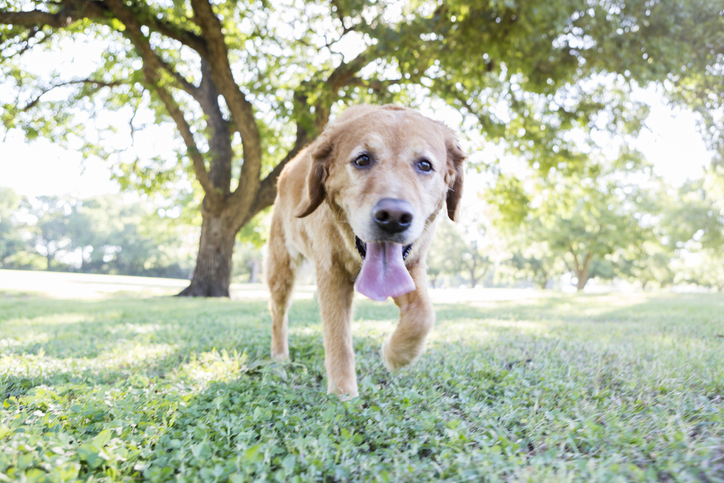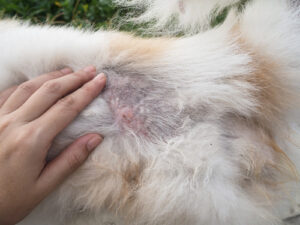Summer is a perfect time to be outside with your dog for long walks or throwing a ball. But as the heat rises in the summer months, it’s important to ensure your dog’s safety to avoid heat stroke. Dogs don’t sweat like humans. Instead, they pant to remove heat from their bodies. But sometimes panting isn’t enough to cool your dog down. This could lead to heat stroke, which is deadly if left untreated. Here are heat stroke symptoms and treatments to be aware of to keep your pet healthy and safe in the summer heat.
What Is Heatstroke?
Heatstroke is characterized by high body temperatures. When a dog’s body temperature reaches above 105° Fahrenheit, it may have heatstroke. Heat stroke progresses rapidly. It causes damage to your dog’s tissues and central nervous system which can lead to organ damage or complete shutdown. Dogs diagnosed with heat stroke can lead to death within 24 hours due to organ failure. The organs mainly at risk when a dog has heat stroke are
- Heart
- Central nervous system
- Kidneys,
- Central nervous system
- Liver
What are the Symptoms of Heat Stroke?
Symptoms of heat stroke in dogs include:
- Excessive drooling
- Lethargy
- Heavy panting
- Trouble breathing
- Drowsy
- Loss of balance
- Collapse and weakness
- Disorientation
- Stumblings
- Seizures
- Vomiting
- Diarrhea sometimes with blood
- Tachycardia
- Red gums

How Do Dogs Get Heat Stroke?
Hot, humid temperatures put dogs at risk for heat stroke, but other things can contribute to your dog getting heat stroke.
Dogs at risk for heat stroke
- Dogs with thick fur
- Brachycephalic breeds, dogs with short noses
- Dogs with medical conditions such as hypothyroidism, laryngeal paralysis, cardiac disease
- Older or younger dogs
- Dogs that are out of shape
- Overweight dogs
Environments
Certain environments can raise a dog’s risk of heat stroke. Being in a close car is generally a common place for a dog to get heat stroke. Temperatures inside a closed car become extremely high within minutes. Other places where dogs are prone to heat stroke include
- Outside enclosed exercise pen without shade or water
- Swimming pools decks without shade or access to drinking water
- Dogs left in outside cages without water or shade
Too much exercise
Avoid exercising your dog in the hottest part of the day on extremely warm days. Your dog can get heatstroke from a short walk on a hot summer day. When it’s especially hot outside, walk your dog in the early morning or late evening. Be sure to give your dog fresh water throughout the day.
What Can you do if your Dog is Overheated?
It’s important to understand the difference between heat stroke and heat exhaustion. These conditions are two very different heat-related health problems. Here are the different symptoms of these two conditions.
Heat stroke
- Elevated body temps over 105°
- Heavy panting
- Disoriented
- Racing heart rate
- Vomiting or diarrhea
- Seizures
- Fast heart rate
Heat exhaustion
- Acts distressed
- Weakness
- Dizziness or fainting
- Nausea
- Panting more than normal
If you notice your dog is getting overheated, try these things to cool them off.
- Take them to a cool, well-ventilated area.
- Spray your dog with cool or tepid water( never cold water) on the back and underside of their body.
- Turn on a fan to help them cool off.
- Give your dog water, but don’t force your dog to drink
- Place a wet, soaked towel on their backs and head

What Should you do if you Suspect your Dog has Heat Stroke?
Call a vet if you suspect your dog is suffering from heat stroke. Or, if you know of an emergency vet in your area, take them there immediately. Drive with your air conditioner on high and windows open to help cool off your dog. Heat stroke can lead to death within 24 hours. Although dogs that survive heat stroke won’t have long-term effects, they may be more susceptible to getting it again. But if your dog’s body temperature gets too high, they may suffer from permanent kidney or brain damage or damage to other organs.
How to Prevent Heat Stroke in your Dog?
It’s easy to forget that summer heat affects dogs differently than humans. Dogs can’t communicate their distress when they’re overheated on a hot, humid day. Be sure to pay attention to the temperature outside and your dog’s safety. You can prevent heat stroke in your dog with these practices.
- Walk your dog in the cooler mornings or evenings. If it’s extremely humid, cut the walk short, allowing your dog time to do their business, and then go back inside where it’s cool.
- If you and your dog are outside, find the shadest spot to hang out.
- Have lots of water available for your dog
- Never leave your dog in a car
- Never leave your dog in an outside exercise pen without shade or water
On the hottest summer days, the best practice could be to leave your dog home in the air conditioning. Don’t risk your pet getting unnecessary heat stroke.
Conclusion
Summer is a great time to play frisbee or go for a fun walk with your dog. But the hot, humid summer days could put your pet at risk for heat stroke. Be sure to plan ahead if you’re outside with your dog when it’s hot. Don’t overlook symptoms that could indicate your dog is struggling with the heat. Be aware of ways to keep your dog cool while outside to stay healthy and safe all summer.
If you have any questions about your dog’s health, please call us at (303) 424-4439 or schedule an appointment with us online!





